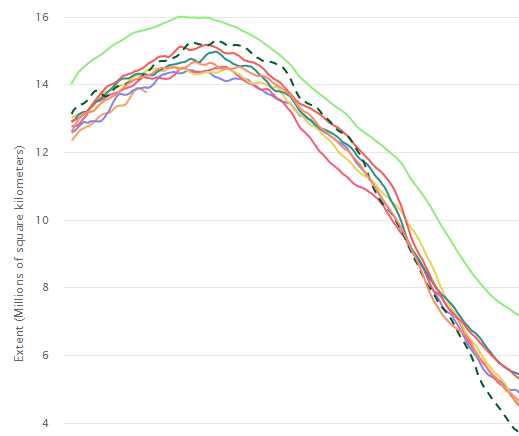Five point five degrees Celsius above average.
That’s how much warmer than ‘normal’ the entire region of the Arctic above the 66 degree North Latitude Line was earlier today. Areas within this large warm pool saw temperatures spike to a range of 15 to 25 C warmer than the already warmer than normal 1981-2010 base period. And broad regions saw temperature between 10 and 20 C above that 30-year average.
(The entire Arctic is an incredible 5.5 C warmer than normal today. Meanwhile, Arctic sea ice extent has plunged, once-more, into record low ranges. Image source: Climate Reanalyzer.)
It’s just a snapshot. But day after day, week after week, month after month, the story has been much the same throughout Fall and Winter of 2017-2018.
And as during last year’s ridiculously warm Arctic winter, the sea ice has taken a considerable pounding. Yesterday dropping to a new record low extent of 13.774 million square kilometers. Beating out the previous record low for the day set just last year. And dipping more than 1.8 million square kilometers below the 1979-1990 average. A period that already featured greatly reduced Arctic sea ice cover when compared to extents seen in the early 20th Century.
(Arctic sea ice extent for 2018 [lower pink line above] dipped into new record low ranges during recent days. Note that the 1979 – 1990 extent average is indicated by the green line at top. Image source: NSIDC.)
The primary cause of these ice losses is warming both of the ocean and of the air. And, as we can see in the ongoing trend, the Arctic is getting more than its fair share of both. Such polar amplification is a direct upshot of the massive volume of harmful greenhouse gasses being injected into the atmosphere through fossil fuel burning. And we are seeing the dark fruits of that burning now in the massive and ongoing winter losses of sea ice, the harm to various Arctic life forms like puffins and polar bears, and the risk of increasing sea level rise, ocean circulation destabilization, and increasingly extreme weather events that all result from the heating-up of polar environments.
















